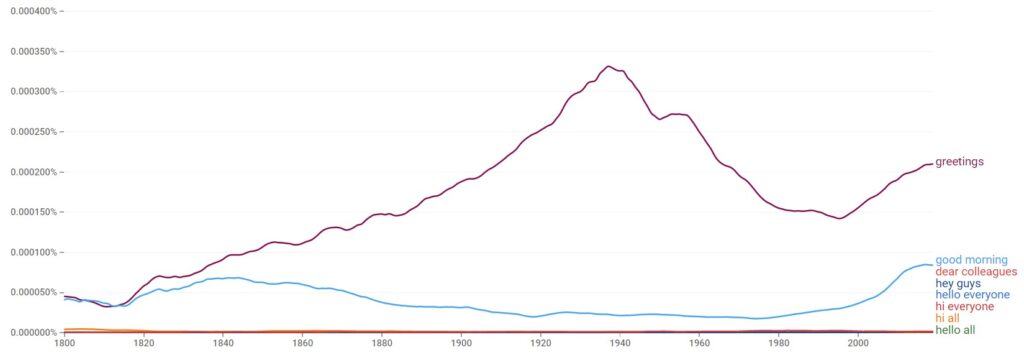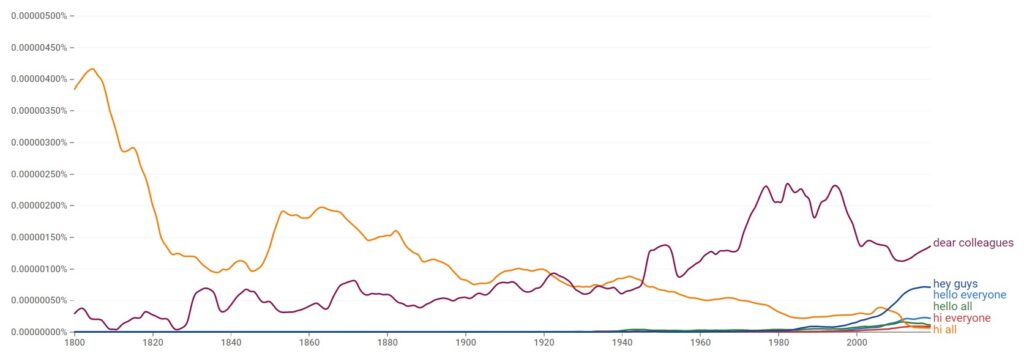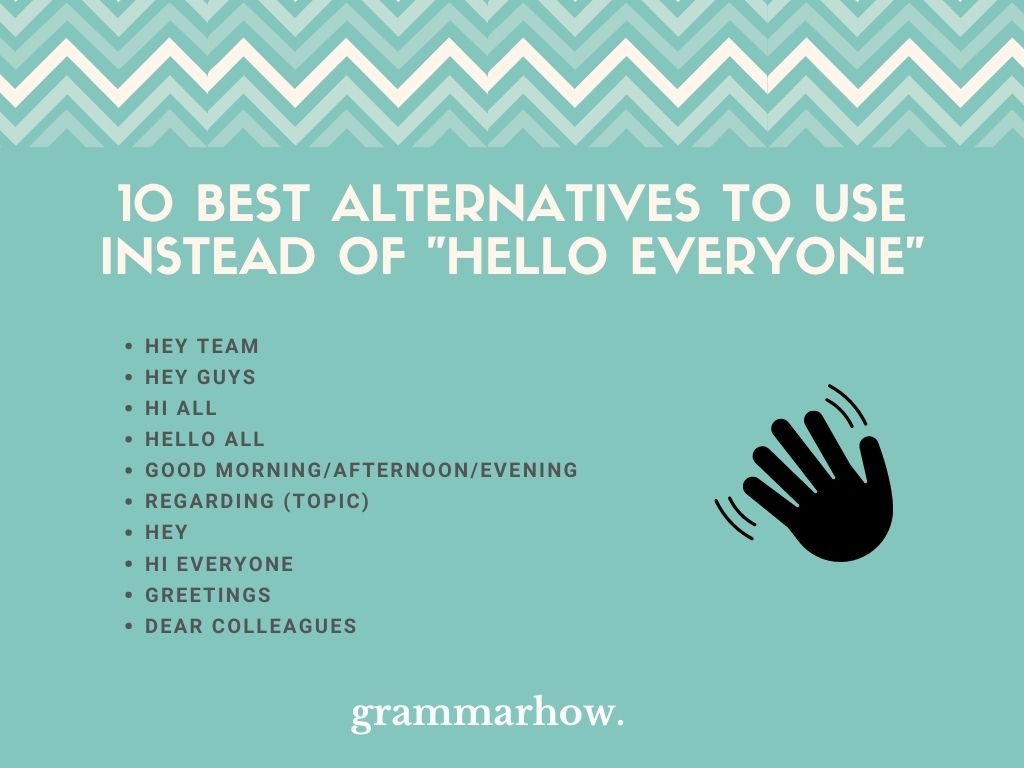“Hello everyone” can be a common starter for work emails. We might also find similar words like “hello everybody” or “hi everybody” used too. Are any of these acceptable, though? This article will explain all the answers to help you out!
Is It Correct To Say “Hello Everyone”?
“Hello everyone” is correct when we are using it to address everyone in the email thread. However, it is very impersonal and lacks a lot of character. “Hello” is an almost robotic way to greet someone, and “everyone” doesn’t make anybody feel special.
“Hello everyone” is technically professional, so there are no reasons why you can’t use it. However, if you want to make sure you sound more like a human being than a robot, it might be better to try out an alternative that we’ll get to later on.
It might be wise to refer your attention to Google Ngram Viewer briefly. We’ve included almost all of the alternatives you’ll see in this article, and you can tell that “hello everyone” is barely even a contender when combined against “greetings” and “good morning.”

However, we also think it’s unfair to use a graph including “greetings” and “good morning” to talk about emails since they are common greetings used throughout English.
Therefore, we also think it’s fair to refer to this graph from Google Ngram Viewer. Now that “greetings” and “good morning” have been removed, you can see that “dear colleagues” is the next best option. After that is “hey guys,” but then it’s “hello everyone.”

The graph above makes it much clearer that “hello everyone” is still acceptable (even if it is incredibly impersonal).
“Hello Everyone” vs. “Hello Everybody”?
“Hello everyone” and “hello everybody” are identical ways to greet someone on a professional email. We can use “everyone” and “everybody” synonymously to address a group. They are both still very impersonal messages, and there are plenty of better alternatives.
According to Google Ngram Viewer, “hello everyone” is the more popular choice in comparison with “hello everybody.” While they are both used, it seems like “everyone” is the more professional phrase that most people stick to, so it’s probably best to use that.

Again, though, there are plenty of better options out there! It’s about time we shared with you what those options are!
10 Best Alternatives To Use Instead Of “Hello Everyone”
Okay, so what options do we have in a professional setting that will make us sound less like a robot? Give one of the following a try and find out for yourself:
- Hey team
- Hey guys
- Hi all
- Hello all
- Good morning/afternoon/evening
- Regarding (topic)
- Hey
- Hi everyone
- Greetings
- Dear colleagues

Hey Team
“Hey team” is a great way to replace “hello everyone.” Since most of the problem comes from “hello,” the simple transition into “hey” can be much more rewarding and inclusive. Using “team” to address your group shows that everyone is equal as well.
It’s a great way to show that your team matters to you. It might only be a small tweak, but it’s great to share some character in your emails.
“Hey team” works best when you know most of the members in your team, and you have a good relationship with them.
Let’s see how we can get this one to work:
- Hey team,
- It’s only me, and I think it’s important that we discuss the matters raised in the meeting.
- Best regards,
- John Walker
- Hey team,
- How many of you have already signed up for the coming event? I think we need a few more before we can get it working seamlessly!
- Thank you,
- Mr. Pink
Hey Guys
In a similar vein, “hey guys” works well to be inclusive and show that everyone is equal. Using “guys” means that you believe everyone is the same in your company and there is no specific hierarchy that you want to address in the email.
The only issue with this is it’s slightly more informal than “hey team.” You have to be really familiar with the people you’re emailing to get this one right!
Here’s how we can get this one to work:
- Hey guys,
- There are a couple of reports from some of you that you’re not best pleased about current practices.
- I would like to discuss these matters more with you in person,
- Christina Pavrotti
- Hey guys,
- I am shooting this email to you all to ask if there’s anyone who is willing to cover the upcoming holiday dates?
- We need everyone to work together here,
- Mr. Paulson
Hi All
Again, “hello” is the biggest problem in “hello everyone.” Replacing it with a simpler “hi” is a much better way to show you’re being more personal. Also, “all” is a good replacement for “everyone” to show that you are referring to everyone to who the message is sent.
This is a fairly common way for people to address groups in their emails. “All” is still a little impersonal, but it’s usually better than opting for “everyone.”
We can use this phrase in the following ways:
- Hi all,
- I know it’s early, but I could really do with a few hands on deck with this project.
- Thank you for your time,
- Mrs. Harrington
- Hi all,
- I have a few things that I need to get done before coming in today, so I’ve left Matthew in charge of the team.
- I appreciate your hard work,
- Daniel
You may also like: “Hi all” or “Hi All” – Correct Version (Formal Email)
Hello All
“Hello all” is another reasonable solution. However, we do not think it’s as personal as “hi all.” It’s more in line with “hello everyone,” but that doesn’t mean it’s incorrect.
You can still use “hello all” in a professional setting. It might be a little impersonal, but it’s a good way to address a group of people you don’t know very well.
Here are some examples to help you with it:
- Hello all,
- I know it’s been a while since I’ve contacted you about this, but we need to discuss the matter again.
- Thank you for your patience,
- Travis Mayer
- Hello all,
- It’s been a long time coming, and it’s finally time for your annual reviews.
- Let me know what time works best for you,
- Sarah Harding
Good Morning/Afternoon/Evening
“Good morning” (or any other time of day) is a great way to greet someone. It shows that you’ve taken the time to check what time of day it is before sending your message, and it’s a friendly approach to an email.
Even in professional settings, a simple “good morning” goes a long way. It shows that you’re interested in your colleague or employees having a good day.
These examples are going to help you make some more sense of it:
- Good morning,
- Are you doing okay? I notice that you haven’t been at work for a few weeks now.
- I hope you’re well,
- Maria Hill
- Good afternoon,
- Let’s discuss the contents of the meeting with each other to make sure we’re all on the same page with this, okay?
- Let me know what you think,
- Lancaster & Co.
- Good evening,
- I’m eager to hear what the team thinks about the recent changes. I think they will be very beneficial for us.
- Thank you,
- Dame Edna
Regarding (Topic)
“Regarding” is a very formal option, but it works well in some cases. If you like the formality, you can use “regarding” as the introductory phrase and skip a specific greeting altogether.
To get this right, you usually follow “regarding” with the specific topic you want to talk about directly after it.
This is perhaps the most professional one you can use, as you’ll see from the following:
- Regarding the meeting on Sunday,
- We have got to make sure that everyone is going to attend this. It’s vital that we are all there.
- Kindest regards,
- Sir Martin
- Regarding your recent hearing,
- I think it’s best that we do not discuss the matter over email, so I expect to see you in my office again this evening.
- Thank you,
- Mrs. Horason
Hey
“Hey” is the simplest way to refer to a group of people in an email. It still works in professional settings, but you need to be careful because it can just as easily refer to one person as multiple people.
It’s also quite informal, so you need to know your audience before using “hey.” You won’t want to get in trouble if you use an informal phrase like this to start your emails!
While simple, we can still use this as a greeting in the following situations:
- Hey,
- How are you all doing? It’s been a while since I sent you an email like this,
- I look forward to hearing from you soon,
- Jessica Jones
- Hey,
- I have a few things that I would like to say in this email if you’d just bear with me.
- All the best,
- Mr. Christopher
Hi Everyone
“Hi everyone” needs to be covered briefly. As we’ve stated, “hello” is the biggest problem with “hello everyone.” Sometimes, simply replacing the impersonal “hello” with the more informal “hi” (or “hey”) works much better.
“Hey everyone” is another good choice which we can use. It depends mainly on the type of company you work for and how they treat informal phrases like this.
You’ll be better off using any of the other alternatives in this article for the most part. We thought it would be good to briefly mention the synonyms for “hello,” though.
Here are some examples that show you how a simple “hi” could change your personality:
- Hi everyone,
- It’s been really nice to have you all back in the office again, and I can’t wait for what’s to come.
- I look forward to working with you soon,
- George Mark
- Hi everyone,
- I hope you’re well. Let’s get down to business right away,
- Kind regards,
- Jackie Change
Greetings
“Greetings” is a jovial and fun way to greet the people you work with. It’s a great way to show your character because it’s not a common word these days. It’s used in a much more jokey way, which shows you can relate and have some fun with your team.
It works well because people don’t often introduce their emails with “greetings.” It’s also still a formal word, so you can get away with it no matter who you’re talking to.
While there is a somewhat joking tone about the word, it still works in many cases when you want to impress the people higher up than you.
This works really well when you’re more familiar with your staff, as you can see from the following:
- Greetings,
- This email is for those of you that need to learn a bit more about how to write emails,
- I wish you all the best,
- Mrs. MacKnade
- Greetings all,
- I hope this email is in good taste, as I have a few things I would like to go over with you,
- Thank you very much,
- Sam Jones
Dear Colleagues
“Dear colleagues” is the last one we want to go through. “Dear” is a common replacement for “hello” or “hi” in an email, and “colleagues” allows us to be more specific about the group of people we’re talking to.
You can go even more specific if you know there’s a specific name attributed to the people receiving your email. For example, “dear team B” or “dear the IT department” are two great ways to show that you care about the people you’re emailing.
Here are some examples that should help you with this one:
- Dear colleagues,
- I hope this email finds you well, and you are ready for the working day ahead,
- Kind regards,
- Matt Smith
- Dear colleagues,
- I have heard a lot of great things about this body of email text,
- All the best,
- Mr. Danforth
Final Thoughts
“Hello everyone” works, but it’s not your best choice. Instead, you should focus on more inclusive phrases that work well to give you character. Using “hey team” and “hey guys” is a great way to show that you care about the people you work with.
As a side note, if you work in a very strict office or company, then a simple “regarding” introduction might be your better choice.
You may also like: 10 Best Ways To Address Multiple People In An Email

Martin holds a Master’s degree in Finance and International Business. He has six years of experience in professional communication with clients, executives, and colleagues. Furthermore, he has teaching experience from Aarhus University. Martin has been featured as an expert in communication and teaching on Forbes and Shopify. Read more about Martin here.
